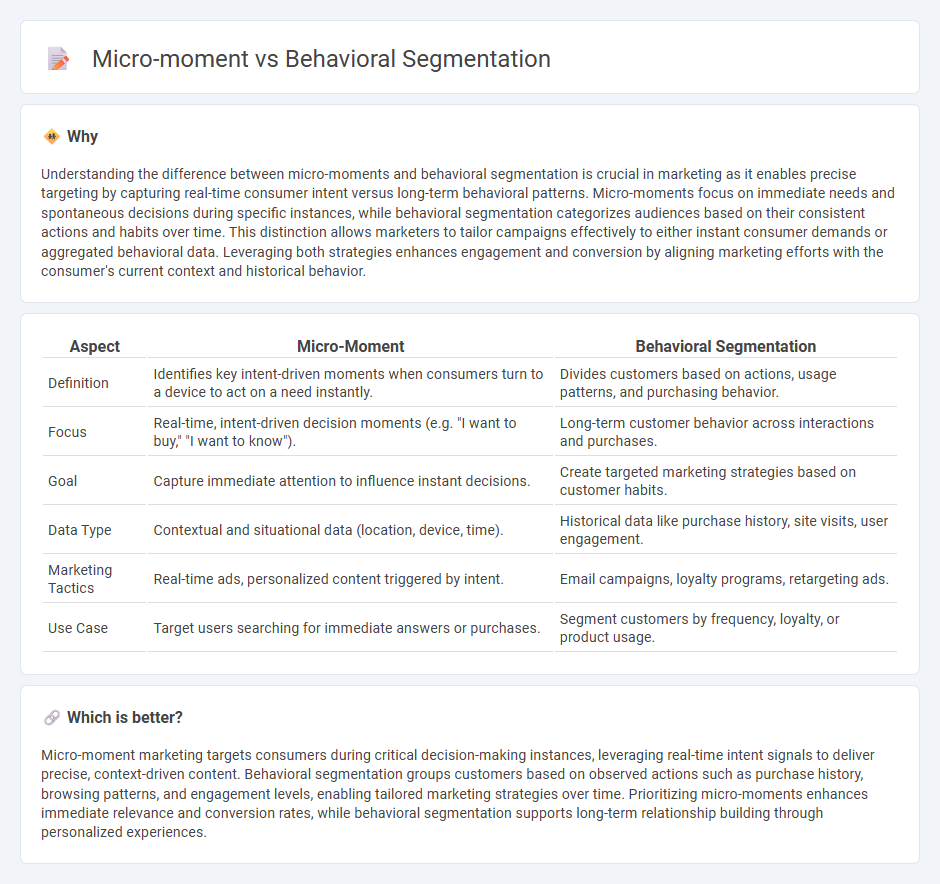
Micro-moment marketing captures consumers' intent instantly by targeting their immediate needs during specific moments, while behavioral segmentation focuses on categorizing customers based on their long-term actions and patterns. Leveraging micro-moments enhances real-time engagement, whereas behavioral segmentation provides deeper insights for personalized marketing strategies. Discover how integrating both can transform your marketing effectiveness.
Why it is important
Understanding the difference between micro-moments and behavioral segmentation is crucial in marketing as it enables precise targeting by capturing real-time consumer intent versus long-term behavioral patterns. Micro-moments focus on immediate needs and spontaneous decisions during specific instances, while behavioral segmentation categorizes audiences based on their consistent actions and habits over time. This distinction allows marketers to tailor campaigns effectively to either instant consumer demands or aggregated behavioral data. Leveraging both strategies enhances engagement and conversion by aligning marketing efforts with the consumer's current context and historical behavior.
Comparison Table
| Aspect | Micro-Moment | Behavioral Segmentation |
|---|---|---|
| Definition | Identifies key intent-driven moments when consumers turn to a device to act on a need instantly. | Divides customers based on actions, usage patterns, and purchasing behavior. |
| Focus | Real-time, intent-driven decision moments (e.g. "I want to buy," "I want to know"). | Long-term customer behavior across interactions and purchases. |
| Goal | Capture immediate attention to influence instant decisions. | Create targeted marketing strategies based on customer habits. |
| Data Type | Contextual and situational data (location, device, time). | Historical data like purchase history, site visits, user engagement. |
| Marketing Tactics | Real-time ads, personalized content triggered by intent. | Email campaigns, loyalty programs, retargeting ads. |
| Use Case | Target users searching for immediate answers or purchases. | Segment customers by frequency, loyalty, or product usage. |
Which is better?
Micro-moment marketing targets consumers during critical decision-making instances, leveraging real-time intent signals to deliver precise, context-driven content. Behavioral segmentation groups customers based on observed actions such as purchase history, browsing patterns, and engagement levels, enabling tailored marketing strategies over time. Prioritizing micro-moments enhances immediate relevance and conversion rates, while behavioral segmentation supports long-term relationship building through personalized experiences.
Connection
Micro-moments in marketing capture consumers' intent-driven, real-time interactions, allowing brands to deliver personalized content exactly when users seek information. Behavioral segmentation categorizes audiences based on their actions, preferences, and engagement patterns, providing granular insights into customer behavior. Combining micro-moments with behavioral segmentation enables marketers to tailor strategies that respond to specific user needs and decision-making processes, enhancing conversion rates and customer experience.
Key Terms
Consumer Behavior Patterns
Behavioral segmentation categorizes consumers based on purchasing habits, usage rate, and brand loyalty, enabling marketers to tailor strategies to distinct groups. Micro-moments capture real-time consumer intent through their immediate needs and context, often via mobile interactions, revealing spontaneous decision-making patterns. Explore deeper insights on how these approaches decode consumer behavior patterns effectively.
Real-time Intent
Behavioral segmentation categorizes consumers based on past actions, purchase history, and interaction patterns to predict future behavior. Micro-moment marketing targets real-time intent, capturing immediate consumer needs through timely, context-driven engagement on digital devices. Explore how leveraging real-time intent through micro-moments can enhance your behavioral segmentation strategies for more precise consumer targeting.
Personalization
Behavioral segmentation divides consumers based on actions, such as purchase history, usage frequency, and brand loyalty, enabling personalized marketing strategies aligned with user behavior. Micro-moments target users' immediate intent by delivering highly relevant content during specific moments of need, optimizing personalization in real time across mobile and digital platforms. Explore how integrating behavioral segmentation with micro-moment marketing enhances personalization and drives deeper consumer engagement.
Source and External Links
Defining Behavioral Segmentation with 7 Examples - Instapage - Behavioral segmentation divides consumers based on how they interact with a brand, focusing on purchasing behavior types like complex, variety-seeking, dissonance-reducing, and habitual behaviors to tailor marketing strategies effectively.
Behavioral segmentation: How it works, types, and examples - Insider - Behavioral segmentation involves organizing target audiences by key behaviors to analyze how customers interact with brands and to deliver personalized marketing content and recommendations.
What Is Behavioral Segmentation in Marketing? (And Examples) - Indeed - Behavioral segmentation groups customers by common behaviors and patterns to better understand, engage, and meet customer needs beyond demographics, enhancing marketing effectiveness and sales.
 dowidth.com
dowidth.com